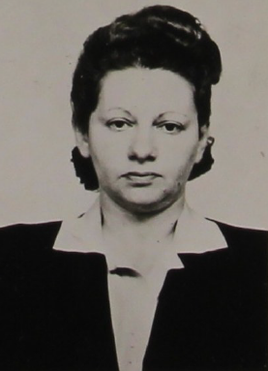Rachel Dübendorfer
Rachel Dübendorfer | |
|---|---|
 Image of Rachel Dübendorfer taken in 21 April 1944 | |
| Born | Rachel Hepner 18 July 1900 |
| Died | 3 March 1973 (aged 72) |
| Nationality | Polish German Swiss |
| Spouse(s) | Kurt Caspary Henri Dübendorfer Paul Böttcher |
| Parent | Adolf Hepner (father) |
| Espionage activity | |
| Service branch | Red Three |
| Service years | 1942–1945 |
| Codename | Sissy |
Rachel Dübendorfer (née Hepner;[1] 18 July 1900 – 3 March 1973)[2] was an anti-Nazi resistance fighter. During the Second World War, her codename was Sissy, and she was in a section of the Red Three Swiss resistance movement.
Personal life[edit]
Dübendorfer was born in Warsaw, Poland in 1900.[2] She was the daughter of Adolf Hepner,[2] and was Jewish.[3][4] She moved to Germany in the 1920s and moved to Nürensdorf, Switzerland in 1933.[2] She was married twice: first to German lawyer Kurt Caspary around 1921, then to Swissman Henri Dübendorfer, which allowed her to gain Swiss citizenship, in 1934. This marriage ended in divorce in 1946. She became the lover of Paul Böttcher.[5] She died in 1973 in East Berlin, East Germany.[2]
Career[edit]
In 1918, Dübendorfer joined the Communist Party of Germany.[1] In 1927, she joined the Soviet Main Intelligence Directorate (GRU),[1][2] where she worked alongside Paul Böttcher.[2] At the start of the Second World War, she worked as a secretary at the League of Nations International Labour Organization and also led a group of Swiss communist informants in Geneva, Switzerland.[4] Dübendorfer began receiving sensitive information from sources in the organisation.[6] She received intelligence reports from German refugee Rudolf Roessler[7][8] (nicknamed Lucy)[5][6] in return for not revealing his identity.[8] Their operation was known as the Lucy spy ring.[5]

In May 1941, Dübendorfer met Alexander Radó for the first time.[4] In 1942, she was in a section of Rado's Red Three resistance movement.[7] Others in the movement included Georges Blun and Otto Pünter.[5][9] In 1942, Dübendorfer received German military information about the planned Case Blue invasion of the Soviet Union (USSR), which was eventually transmitted to the Soviet Union.[6]
Initially, Dübendorfer did not mention to Radó the name of Roessler, her most important informant.[3] In November 1943, Dübendorfer became the lone Red Three member after leaders, including Radó, were arrested and imprisoned.[10] Dübendorfer tried unsuccessfully to contact Moscow through Hermina Rabinovitch, a friend who lived in Montreal, Canada.[11]
Afterward, Dübendorfer refused to co-operate with Soviet leader Joseph Stalin and did not want to send information back to Moscow.[5] She provided information to MI6 officers in Switzerland, under the proviso that this information was not shared with Moscow.[3] In April 1944, Dübendorfer and Böttcher were captured.[10] She was imprisoned in the USSR and later East Germany from 1946 until 1956 and so she never became a leader.[1]
References[edit]
- ^ a b c d "Ergebnis der Suche nach: nid=1065691734" (in German). German National Library. Retrieved 17 January 2019.
- ^ a b c d e f g "Dübendorfer, Rachel" (in German). Historical Dictionary of Switzerland. 10 June 2002. Retrieved 15 January 2019.
- ^ a b c Day, Peter (2014). Klop: Britain's Most Ingenious Secret Agent. Biteback Publishing. ISBN 9781849547642. Retrieved 15 January 2019.
- ^ a b c Haufler, Hervie (2014). Codebreakers' Victory: How the Allied Cryptographers Won World War II. Open Road Integrated Media. ISBN 9781497622562. Retrieved 17 January 2019.
- ^ a b c d e Kilzer, Louis (2000). Hitler's Traitor: Martin Bormann and the Defeat of the Reich. Presidio Press. Retrieved 15 January 2019 – via WorldCat.
- ^ a b c Ginsberg, Benjamin (2013). How the Jews Defeated Hitler: Exploding the Myth of Jewish Passivity in the Face of Nazism. Rowman & Littlefield. pp. 84–85. ISBN 9781442222380. Retrieved 17 January 2019.
- ^ a b Richelson, Jeffery T. (1997). A Century of Spies: Intelligence in the Twentieth Century. Oxford University Press. p. 184. ISBN 9780199880584.
- ^ a b Crowdy, Terry (2011). The Enemy Within: A History of Spies, Spymasters and Espionage. Bloomsbury Publishing. ISBN 9781780962436. Retrieved 16 January 2019.
- ^ Richelson, Jeffrey T. (1997). A Century of Spies: Intelligence in the Twentieth Century. Oxford University Press. p. 127. ISBN 9780195113907. Retrieved 17 January 2019.
- ^ a b "Werther hat nie gelebt". Der Spiegel (in German). 10 July 1972. Retrieved 15 January 2019.
- ^ West, Nigel (2007). Mask: MI5's Penetration of the Communist Party of Great Britain. Routledge. ISBN 9781134265756. Retrieved 15 January 2019.
- 1900 births
- 1973 deaths
- Jews in the German resistance
- Polish resistance members of World War II
- Red Orchestra (espionage)
- Polish emigrants to Switzerland
- Communist Party of Germany members
- Polish spies for the Soviet Union
- Female wartime spies
- World War II spies for the Soviet Union
- World War II spies for the United Kingdom
- Swiss spies
- Polish emigrants to East Germany
